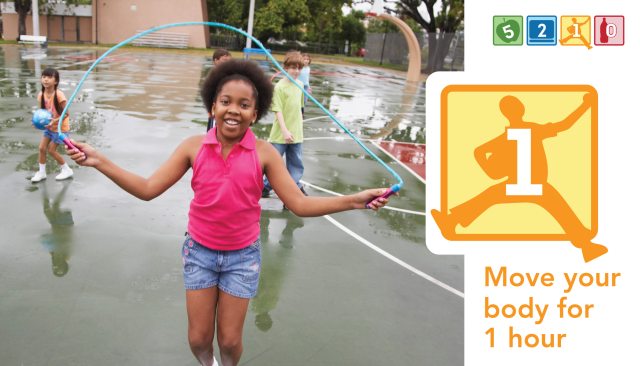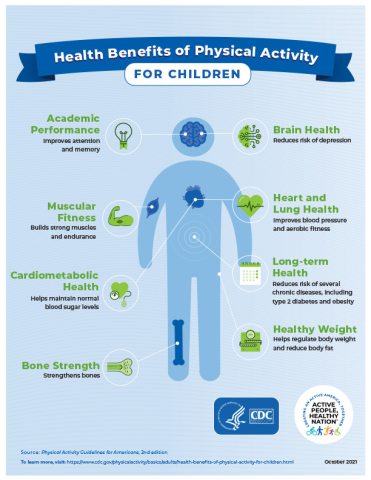Daily 5-2-1-0: Move your body for 1 hour

Just 60 minutes of any kind of movement can do wonders for kids’ health.
The number one—in the 5-2-1-0 plan—represents the daily goal to physically move for at least one hour per day.
“It’s all part of helping kids remember how to start and stick with healthy daily practices,” according to Misty Carlson, MD, pediatric cardiologist at PeaceHealth Sacred Heart Medical Center at RiverBend in Springfield, Oregon. “This is an especially powerful habit as there are numerous benefits to any kind of physical activity.”
Benefits of physical movement
Here’s what exercise or moving more can do for children, according to the CDC:
- Improve attention and memory.
- Improve mood and reduce the risk of depression.
- Build strong muscles and endurance.
- Improve blood pressure.
- Help maintain normal blood sugar levels.
- Reduce risk of several chronic diseases, including type 2 diabetes and obesity.
- Strengthen bones.
- Help regulate body weight.
Also according to the CDC, “it is important to provide young people opportunities and encouragement to participate in physical activities that are appropriate for their age, that are enjoyable, and that offer variety. Children and adolescents ages 6 through 17 years should do 60 minutes or more of moderate-to-vigorous physical activity daily.”
What counts as physical activity?
Following are different types of activity that benefit every age:
- Aerobic – this is any activity that makes the heart beat faster or harder than when it is at rest. This includes walking, running, jumping rope, dancing, swimming or bicycling. This helps the heart and lungs. Short bursts or prolonged periods of this type of activity can both be beneficial. Most of the daily 60 minutes should be this kind of activity and at a moderate to vigorous level of intensity. The CDC recommends that at least three days a week, a child’s daily movement should include vigorous-intensity activity. (Use the talk test to measure intensity.)
- Stretching – slow, gentle movement such as yoga, help muscles and joints loosen up. Most children are flexible by nature but purposeful stretching is a habit that will serve them well as they get older.
- Strength training –your child’s one hour movement goal should include the following at least three days a week:
- Muscle-strengthening activities such as bicep curls, push-ups or climbing. Encourage activities that build both upper- and lower-body strength.
- Bone-strengthening activities that work the body against gravity, such as jogging, jumping and dancing. (Swimming and cycling are not considered weight-bearing.)
Strength training is best done little by little over time. And be sure to foster proper techniques so children don’t hurt themselves or get into bad habits that could put them at risk of injury.
Tips to help kids move for at least one hour a day:
- Set the example. Children watch what adults do. When YOU are physically active, you set a good example for them to follow.
- Make it social. Doing an activity with other people often makes it more enjoyable. It also helps with accountability. “Families can find an activity to do together such as going on a long walk, hiking, biking, or playing a backyard game (basketball, pickle ball, yard games),” says Dr. Carlson. “Everybody can be involved with the activity and it can be easier for children to join in.”
- Do it outside. Getting out of the house is a great way to be intentional and committed to an activity. Plus “being in nature can have added health benefits than physical activity alone,” notes Dr. Carlson.
- Break it up. If one hour sounds like a lot, try two 30-minute or three 20-minute blocks of time. Sometimes starting is the hardest part and once they get into an activity, they might want to keep going.
- Make it fun. What are your child’s favorite activities? Playing with the dog? Having a catch? Kicking a soccer ball? Dancing? Tap into what your child finds delightful and the time will fly.
- Keep it safe. Set rules and expectations that are age- and development-appropriate. Always wear a helmet when cycling or skating. Always have a buddy when swimming or walking in the neighborhood.
- Weave it in. When the kids are watching a TV show, have them try holding a plank during a commercial. Or ask your child for help to do a physically active chore (e.g., putting away laundry or taking out the garbage) as a break from a sedentary activity.
Talk with your child’s pediatrician at the next office visit about strategies for making step-by-step changes that will stick.
This article is the fourth in a series about the 5-2-1-0 approach to promoting healthy habits.






